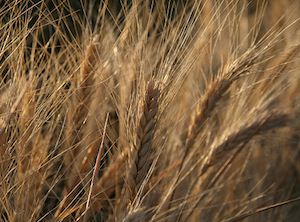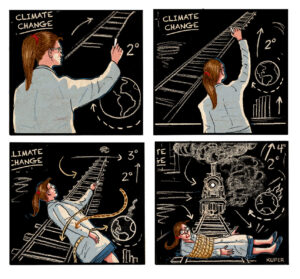Warming Climate Endangers U.K. Farming
British farm animals and crops face a heightened health risk from several diseases encouraged by climate change.
By Kieran Cooke, Climate News NetworkThis piece first appeared at Climate News Network.
LONDON — They are short, have a tough outer skin and are capable of doing a great deal of damage – at least to lawns, grasslands and to cereal crops.
Leatherjacket grubs – Tipula oleracea – are the larvae of crane flies, the insects with slender wings and arched legs more commonly known – at least in the United Kingdom – as “daddy-long -legs”.
Agriculture experts in Scotland are now suggesting that climate change has been causing recent infestations of the leatherjacket grub in the country, threatening spring-sown cereal crops and grasslands.
Adult crane flies lay their eggs in late summer or early autumn. The larvae – the leatherjacket grubs – live just below soil level and in spring and early summer eat the roots of grasses and other plants.
Scotland’s Rural College (SRUC), which has six campuses spread across the country, has been carrying out grub surveys for the past 38 years. The latest annual survey data on leatherjacket numbers, collected between November last year and April 2013 in central and western Scotland, found infestations at an exceptionally high level.
Seventy per cent of fields surveyed had grub populations of more than one million per hectare – and some fields had more than seven million per hectare. “The numbers are mind boggling”, Dr Davy McCracken, an ecologist at SRUC, told Climate News Network.
“We’re not forcing the climate change envelope, but the correlation between a succession of mild and wet autumns in this region and the growing number of leatherjackets is striking.
“There tend to be fluctuations in the size of grub densities in grassland from one year to the next. But since 1997/98 we’ve not only seen much larger densities, but also those large average densities have been more sustained from one year to the next.
Risks to crops and animals
“For example, over the last 38 years we have seen 13 years when the average density of grubs was more than a million per hectare – and nine of those high density years have occurred since 1997/98.”
Dr McCracken says that while no comparable surveys have been carried out in England it’s likely that, due to the generally wet but relatively mild weather last autumn, the risk of similar infestations on lands further south is high.
Agriculture experts warn that the heightened grub activity could decrease yields of cereal crops and cause declines in grassland fodder for cattle and other animals. The leatherjacket also attacks potato tubers.
The infestation of leatherjackets is one of a number of climate change-related threats to agriculture. Experts at SRUC have linked changes in climate with the growth of liver fluke disease – a condition which can kill sheep and cattle.
In a recent report it was predicted that an increase in wet, warm winter conditions would likely cause an unprecedented level of the disease in many regions of the UK in future.
Scientists have also linked changes in climate to the spread into areas of northern Europe, including the UK, of the blue tongue virus, another disease that can kill cattle and sheep.
Your support is crucial...As we navigate an uncertain 2025, with a new administration questioning press freedoms, the risks are clear: our ability to report freely is under threat.
Your tax-deductible donation enables us to dig deeper, delivering fearless investigative reporting and analysis that exposes the reality beneath the headlines — without compromise.
Now is the time to take action. Stand with our courageous journalists. Donate today to protect a free press, uphold democracy and uncover the stories that need to be told.







You need to be a supporter to comment.
There are currently no responses to this article.
Be the first to respond.